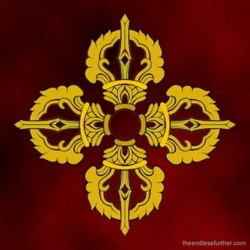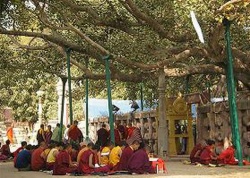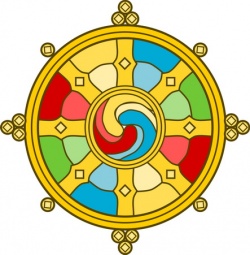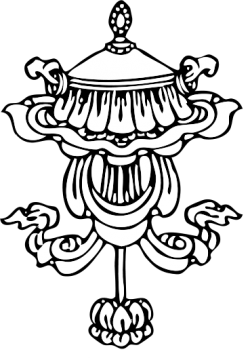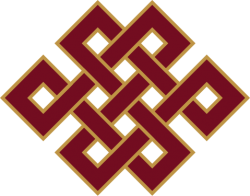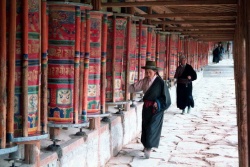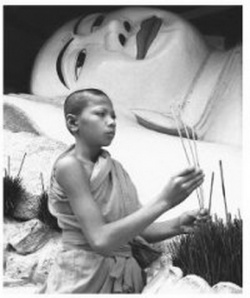Difference between revisions of "Buddhist Symbols"
| Line 8: | Line 8: | ||
Eventually, the [[Buddha]] image became one of the most popular {{Wiki|representations}} in [[Buddhism]], but these early [[symbols]] remain important and are frequently used to this day. They are especially important in [[Theravada]] [[Buddhist]] countries like [[Sri Lanka]] and [[Thailand]]. | Eventually, the [[Buddha]] image became one of the most popular {{Wiki|representations}} in [[Buddhism]], but these early [[symbols]] remain important and are frequently used to this day. They are especially important in [[Theravada]] [[Buddhist]] countries like [[Sri Lanka]] and [[Thailand]]. | ||
| − | As [[Buddhism]] spread, [[Buddhist symbolism]] was enriched by the cultures it came into [[contact]] with. This is especially true of [[Buddhism]] in [[Tibet]], which has developed a rich [[symbolic]] [[tradition]]. The central [[symbols]] of [[Tibetan Buddhism]] are the [[Eight Auspicious Symbols]], known in [[Sanskrit]] as [[Ashtamangala]] ('''[[ashta]]''' meaning eight and '''[[mangala]]''' meaning [[auspicious]]). [[The Eight Auspicious Symbols]] are printed on [[Tibetan]] [[prayer flags]], incorporated into [[mandalas]] and [[thangkas]], and used in other [[forms]] of [[ritual]] [[art]]. Another important [[symbol]] is the [[Wheel of Life]], a [[symbolic]] [[representation]] of the [[universe]] as understood by [[Tibetan]] [[Buddhists]]. | + | |
| + | As [[Buddhism]] spread, [[Buddhist symbolism]] was enriched by the cultures it came into [[contact]] with. This is especially true of [[Buddhism]] in [[Tibet]], which has developed a rich [[symbolic]] [[tradition]]. The central [[symbols]] of [[Tibetan Buddhism]] are the [[Eight Auspicious Symbols]], known in [[Sanskrit]] as [[Ashtamangala]] ('''[[ashta]]''' meaning eight and '''[[mangala]]''' meaning | ||
| + | |||
| + | |||
| + | [[auspicious]]). [[The Eight Auspicious Symbols]] are printed on [[Tibetan]] [[prayer flags]], incorporated into [[mandalas]] and [[thangkas]], and used in other [[forms]] of [[ritual]] [[art]]. Another important [[symbol]] is the [[Wheel of Life]], a [[symbolic]] [[representation]] of the [[universe]] as understood by [[Tibetan]] [[Buddhists]]. | ||
| + | |||
Other important types of [[symbolism]] in [[Buddhism]] include colors, especially the [[five colors]] of white, [[yellow]], [[red]], blue and [[green]], and [[symbolic]] [[hand gestures]] called [[mudras]].The articles in this section explore these [[Buddhist symbols]], providing [[information]] on their history, meaning and use in [[Buddhism]] today. (For an introduction and quick guide to [[Buddhist]] colors, see our Chart of [[Buddhist]] {{Wiki|Color}} [[Symbolism]].) | Other important types of [[symbolism]] in [[Buddhism]] include colors, especially the [[five colors]] of white, [[yellow]], [[red]], blue and [[green]], and [[symbolic]] [[hand gestures]] called [[mudras]].The articles in this section explore these [[Buddhist symbols]], providing [[information]] on their history, meaning and use in [[Buddhism]] today. (For an introduction and quick guide to [[Buddhist]] colors, see our Chart of [[Buddhist]] {{Wiki|Color}} [[Symbolism]].) | ||
| − | + | ||
| + | |||
The [[Buddha]] lived around 6th century BCE. Still, [[Buddhist symbols]] began to appear from around 3rd century BCE only. These [[symbols]] were basically {{Wiki|aniconic}} and did not have [[Buddha]] images as [[symbols]]. It was only in the 1st century CE that the [[Buddha]] was started to be represented in [[human]] [[form]]. Various other [[symbols]] came up later specially from [[Tibetan Buddhism]]. | The [[Buddha]] lived around 6th century BCE. Still, [[Buddhist symbols]] began to appear from around 3rd century BCE only. These [[symbols]] were basically {{Wiki|aniconic}} and did not have [[Buddha]] images as [[symbols]]. It was only in the 1st century CE that the [[Buddha]] was started to be represented in [[human]] [[form]]. Various other [[symbols]] came up later specially from [[Tibetan Buddhism]]. | ||
| + | |||
Since [[Buddhism]] originated in [[India]] where [[Hinduism]] is a predominant [[religion]], many of the early [[symbols]] in [[Buddhism]] are also found in [[Hinduism]]. The meaning of these [[symbols]], however, are not necessarily same. | Since [[Buddhism]] originated in [[India]] where [[Hinduism]] is a predominant [[religion]], many of the early [[symbols]] in [[Buddhism]] are also found in [[Hinduism]]. The meaning of these [[symbols]], however, are not necessarily same. | ||
| + | |||
| + | |||
===1) [[Symbols]] Used for the [[Buddha]]=== | ===1) [[Symbols]] Used for the [[Buddha]]=== | ||
| + | |||
| + | |||
The [[Buddha]] was never comfortable with the [[idea]] of [[people]] worshipping His image. As such, initial [[Buddhist art]] represented the [[Buddha]] in [[form]] of [[symbols]]. These [[symbols]] include the Eight spoked [[Wheel]] (discussed below), the [[Bodhi Tree]], an [[Empty Throne]], a [[Lion]] and the [[Buddha’s]] Footprint. The last one was the the first that gave way to the later [[representation]] of the [[Buddha]] as a [[human]]. | The [[Buddha]] was never comfortable with the [[idea]] of [[people]] worshipping His image. As such, initial [[Buddhist art]] represented the [[Buddha]] in [[form]] of [[symbols]]. These [[symbols]] include the Eight spoked [[Wheel]] (discussed below), the [[Bodhi Tree]], an [[Empty Throne]], a [[Lion]] and the [[Buddha’s]] Footprint. The last one was the the first that gave way to the later [[representation]] of the [[Buddha]] as a [[human]]. | ||
| Line 26: | Line 37: | ||
[[File:BodhiTree.jpg|thumb|250px|]] | [[File:BodhiTree.jpg|thumb|250px|]] | ||
| − | The [[Bodhi Tree]] as a [[symbol]] for the [[Buddha]] is quiet understandable. It was this [[tree]] in [[Bodh Gaya]] that the [[Buddha]] sat under for [[meditation]] after wandering for six years and achieved [[enlightenment]]. [[Bodhi]] in [[Sanskrit]] and [[Pali]] [[language]] means [[enlightenment]]. [[Bodhi tree]] became an obvious [[symbol]] for the [[Buddha]] also because [[tree]] {{Wiki|worship}} was widely prevalent in [[India]] at that point of [[time]]. | + | The [[Bodhi Tree]] as a [[symbol]] for the [[Buddha]] is quiet understandable. It was this [[tree]] in [[Bodh Gaya]] that the [[Buddha]] sat under for [[meditation]] after wandering for six years and achieved [[enlightenment]]. [[Bodhi]] in [[Sanskrit]] and [[Pali]] [[language]] |
| + | |||
| + | means [[enlightenment]]. [[Bodhi tree]] became an obvious [[symbol]] for the [[Buddha]] also because [[tree]] {{Wiki|worship}} was widely prevalent in [[India]] at that point of [[time]]. | ||
| Line 49: | Line 62: | ||
| − | The story of the [[begging bowl]] goes that a little before the [[Buddha]] reached [[enlightenment]], a woman by the [[name]] of [[Sujata]] [[offered]] Him a [[bowl]] of milk {{Wiki|rice}}. The [[Buddha]], at that point of [[time]], was practising austerity and therefore eating very less. However, He realised that without [[food]], He will not have the [[energy]] to continue on his [[path]] to [[enlightenment]]. Therefore, He took some milk {{Wiki|rice}}. As soon as the [[Buddha]] [[attained]] [[enlightenment]], He discarded the rest of the [[food]] that was left. | + | The story of the [[begging bowl]] goes that a little before the [[Buddha]] reached [[enlightenment]], a woman by the [[name]] of [[Sujata]] [[offered]] Him a [[bowl]] of milk {{Wiki|rice}}. The [[Buddha]], at that point of [[time]], was practising austerity and therefore eating very less. However, He realised that without [[food]], He will not have the [[energy]] to continue on his [[path]] to [[enlightenment]]. |
| + | |||
| + | Therefore, He took some milk {{Wiki|rice}}. As soon as the [[Buddha]] [[attained]] [[enlightenment]], He discarded the rest of the [[food]] that was left. | ||
The [[begging bowl]], as a [[symbol]], is therefore indicative of an immensely important [[Buddhist]] [[principle]] – to find a [[balance]] between extreme austerity and complete [[attachment]]. The [[begging bowl]] also stands for the [[monk’s]] way of [[life]] which requires him to roam around and live off what is being given to him by the common [[people]]. | The [[begging bowl]], as a [[symbol]], is therefore indicative of an immensely important [[Buddhist]] [[principle]] – to find a [[balance]] between extreme austerity and complete [[attachment]]. The [[begging bowl]] also stands for the [[monk’s]] way of [[life]] which requires him to roam around and live off what is being given to him by the common [[people]]. | ||
| Line 72: | Line 87: | ||
[[File:1280.JPG|thumb|250px|]] | [[File:1280.JPG|thumb|250px|]] | ||
The [[Dharma Wheel]] is one of the earliest and most important [[symbols]] in [[Buddhism]]. The [[symbol]] refers to the story in which post the [[Buddha’s]] [[enlightenment]], [[Lord]] [[Brahma]] descended from the [[heaven]] and asked Him to teach by [[offering]] a [[Dharmachakra]]. | The [[Dharma Wheel]] is one of the earliest and most important [[symbols]] in [[Buddhism]]. The [[symbol]] refers to the story in which post the [[Buddha’s]] [[enlightenment]], [[Lord]] [[Brahma]] descended from the [[heaven]] and asked Him to teach by [[offering]] a [[Dharmachakra]]. | ||
| + | |||
The [[Dharma Wheel]] is a [[symbol]] of the [[Buddha’s teaching]] of the [[path]] to [[enlightenment]]. The [[Buddha]] is known as the [[Wheel turner]] and as per some [[Buddhist]] Schools, He turned the [[Dharma Wheel]] few times. The first, to which all the [[Buddhist]] agree, was when the [[Buddha]] {{Wiki|preached}} the five [[sages]] at the [[Deer Park]] in [[Sarnath]]. It is because of this that you will quiet often find a {{Wiki|deer}} on each side of the [[Dharmachakra]]. The later turning of [[wheel]] account are not always same. They vary, however what is concluded from this is that the [[dharma wheel]] needs to be turned thrice for a [[student]] to understand [[dharma]]. | The [[Dharma Wheel]] is a [[symbol]] of the [[Buddha’s teaching]] of the [[path]] to [[enlightenment]]. The [[Buddha]] is known as the [[Wheel turner]] and as per some [[Buddhist]] Schools, He turned the [[Dharma Wheel]] few times. The first, to which all the [[Buddhist]] agree, was when the [[Buddha]] {{Wiki|preached}} the five [[sages]] at the [[Deer Park]] in [[Sarnath]]. It is because of this that you will quiet often find a {{Wiki|deer}} on each side of the [[Dharmachakra]]. The later turning of [[wheel]] account are not always same. They vary, however what is concluded from this is that the [[dharma wheel]] needs to be turned thrice for a [[student]] to understand [[dharma]]. | ||
| Line 83: | Line 99: | ||
[[File:Utpala.jpg|thumb|250px|]] | [[File:Utpala.jpg|thumb|250px|]] | ||
| − | [[Lotus]] is the [[symbol]] of [[purity]] of [[body, speech and mind]] in every [[form]]. A [[lotus]] has its [[roots]] in mud ([[samsara]]), the stem grows above the [[water]] and the [[flower]] blooms above the [[water]]. This sort of growth is quiet similar to the growth of being from [[worldly]] {{Wiki|materialism}} to [[enlightenment]]. The practice of [[Buddhist teachings]] elevates the [[mind]] from the [[worldly existence]] and leads it to [[enlightenment]]. In [[esoteric Buddhism]], the hearts of being resembles an unopened [[lotus]] which blooms only when the [[Buddha’s]] [[virtue]] develops within. An open blossom stands for full [[enlightenment]] whereas a closed blossom indicates a scope for [[enlightenment]]. The [[Buddha]] is depicted seated on a [[lotus]] thereby signifying his [[complete enlightenment]]. | + | [[Lotus]] is the [[symbol]] of [[purity]] of [[body, speech and mind]] in every [[form]]. A [[lotus]] has its [[roots]] in mud ([[samsara]]), the stem grows above the [[water]] and the [[flower]] blooms above the [[water]]. This sort of growth is quiet similar to the growth of being |
| + | |||
| + | from [[worldly]] {{Wiki|materialism}} to [[enlightenment]]. The practice of [[Buddhist teachings]] elevates the [[mind]] from the [[worldly existence]] and leads it to [[enlightenment]]. In [[esoteric Buddhism]], the hearts of being resembles an unopened [[lotus]] which blooms | ||
| + | |||
| + | only when the [[Buddha’s]] [[virtue]] develops within. An open blossom stands for full [[enlightenment]] whereas a closed blossom indicates a scope for [[enlightenment]]. The [[Buddha]] is depicted seated on a [[lotus]] thereby signifying his [[complete enlightenment]]. | ||
[[Lotuses]] in [[Buddhism]] are usually represented in 5 colours and are clubbed in group of three to five [[flowers]]. The [[flowers]] may or may not have leaves. | [[Lotuses]] in [[Buddhism]] are usually represented in 5 colours and are clubbed in group of three to five [[flowers]]. The [[flowers]] may or may not have leaves. | ||
| + | |||
| + | |||
* [[White Lotus]] – [[White Lotus]] stands for complete [[mental]] [[purity]] and [[spiritual]] [[perfection]] ([[bodhi]]). A [[white lotus]] is usually shown having [[eight petals]] that stand for [[noble eight fold path]] of the good law. This [[lotus]] is found in the [[heart]] of the grabhdhatu [[mandala]] and is also connected with the [[White Tara]]. White stands for the {{Wiki|perfect}} [[nature]] of the [[White Tara]]. | * [[White Lotus]] – [[White Lotus]] stands for complete [[mental]] [[purity]] and [[spiritual]] [[perfection]] ([[bodhi]]). A [[white lotus]] is usually shown having [[eight petals]] that stand for [[noble eight fold path]] of the good law. This [[lotus]] is found in the [[heart]] of the grabhdhatu [[mandala]] and is also connected with the [[White Tara]]. White stands for the {{Wiki|perfect}} [[nature]] of the [[White Tara]]. | ||
| + | |||
| + | |||
* [[Red Lotus]] – [[Red Lotus]] is [[symbolic]] of the original [[nature]] and [[purity]] of [[heart]]. It stands for [[heart]] that is full of [[love]], [[compassion]] and [[passion]]. Accordingly, the [[Red lotus]] is the [[flower]] of [[Avalokitesvara]] or the [[bodhisattva of compassion]]. | * [[Red Lotus]] – [[Red Lotus]] is [[symbolic]] of the original [[nature]] and [[purity]] of [[heart]]. It stands for [[heart]] that is full of [[love]], [[compassion]] and [[passion]]. Accordingly, the [[Red lotus]] is the [[flower]] of [[Avalokitesvara]] or the [[bodhisattva of compassion]]. | ||
| + | |||
| + | |||
* [[Blue Lotus]] – The [[Blue Lotus]] stands for conquest of [[spirit]] over [[senses]]. It is [[symbolic]] of [[wisdom]], [[knowledge]] and [[intelligence]] and without [[doubts]] it is the [[flower]] of [[Manjushri]], the [[bodhisattva of wisdom]]. The [[blue lotus]] is represented as partially opened bud and in contrast to the [[red lotus]], its centre is never [[visible]]. | * [[Blue Lotus]] – The [[Blue Lotus]] stands for conquest of [[spirit]] over [[senses]]. It is [[symbolic]] of [[wisdom]], [[knowledge]] and [[intelligence]] and without [[doubts]] it is the [[flower]] of [[Manjushri]], the [[bodhisattva of wisdom]]. The [[blue lotus]] is represented as partially opened bud and in contrast to the [[red lotus]], its centre is never [[visible]]. | ||
| + | |||
| + | |||
* [[Pink Lotus]] – This [[lotus]] is associated with the [[historical Buddha]] and is therefore the most important and supreme [[lotus]]. It is generally meant only for the [[highest]] [[deities]]. | * [[Pink Lotus]] – This [[lotus]] is associated with the [[historical Buddha]] and is therefore the most important and supreme [[lotus]]. It is generally meant only for the [[highest]] [[deities]]. | ||
| + | |||
| + | |||
* [[Purple Lotus]] – [[Purple lotus]], as a [[symbol]], is restricted to only few [[esoteric]] sects. The [[flower]] can be shown in full bloom or in a bud and could be supported by single, triple or a quintuple stem. Also, the [[flower]] can be shown in a cup or on a tray as a [[symbol]] of homage. | * [[Purple Lotus]] – [[Purple lotus]], as a [[symbol]], is restricted to only few [[esoteric]] sects. The [[flower]] can be shown in full bloom or in a bud and could be supported by single, triple or a quintuple stem. Also, the [[flower]] can be shown in a cup or on a tray as a [[symbol]] of homage. | ||
| Line 107: | Line 137: | ||
| − | The [[umbrella]] {{Wiki|signifies}} [[wealth]] and royalty. This is because possessing an [[umbrella]] was itself a sign of {{Wiki|prosperity}}. Moreover, one also needed to have a [[person]] specially to carry it. Apart from [[wealth]] and royalty, the [[umbrella]] also symbolises [[activities]] that are conducive for [[moral]] well being. These [[activities]] keep a [[human being]] protected from harms like like {{Wiki|illness}}, harmful forces, [[obstacles]] etc and enable them to enjoy the results. It is just like the [[umbrella]] that protects being from strong rays of {{Wiki|sun}}. | + | The [[umbrella]] {{Wiki|signifies}} [[wealth]] and royalty. This is because possessing an [[umbrella]] was itself a sign of {{Wiki|prosperity}}. Moreover, one also needed to have a [[person]] specially to carry it. Apart from [[wealth]] and royalty, the [[umbrella]] also symbolises [[activities]] that are conducive for [[moral]] well being. These [[activities]] keep a [[human being]] |
| + | |||
| + | protected from harms like like {{Wiki|illness}}, harmful forces, [[obstacles]] etc and enable them to enjoy the results. It is just like the [[umbrella]] that protects being from strong rays of {{Wiki|sun}}. | ||
| Line 165: | Line 197: | ||
| − | [[Vajras]] consist of nine, five or three spokes. They can either be [[peaceful]] or [[wrathful]] [[vajras]]. The upper sets of spokes of the five spoked [[vajra]] stand for [[five wisdom]] – [[mirror]] like [[wisdom]], [[wisdom of equality]], [[wisdom]] of {{Wiki|individual}} analysis, [[wisdom]] of accomplishing [[activity]] and [[wisdom]] of [[sphere of reality]]. The upper sets of spokes in a nine spoked [[vajra]] symbolise the [[Buddha]] of [[five families]] with four mothers in between. The lower spokes here stand for the [[five wisdom]] and four [[desires]] of [[love]], [[compassion]], [[equanimity]] and [[joy]]. | + | [[Vajras]] consist of nine, five or three spokes. They can either be [[peaceful]] or [[wrathful]] [[vajras]]. The upper sets of spokes of the five spoked [[vajra]] stand for [[five wisdom]] – [[mirror]] like [[wisdom]], [[wisdom of equality]], [[wisdom]] of {{Wiki|individual}} |
| + | |||
| + | analysis, [[wisdom]] of accomplishing [[activity]] and [[wisdom]] of [[sphere of reality]]. The upper sets of spokes in a nine spoked [[vajra]] symbolise the [[Buddha]] of [[five families]] with four mothers in between. The lower spokes here stand for the [[five wisdom]] and four [[desires]] of [[love]], [[compassion]], [[equanimity]] and [[joy]]. | ||
| Line 174: | Line 208: | ||
[[File:Prayer_wheels.jpg|thumb|250px|]] | [[File:Prayer_wheels.jpg|thumb|250px|]] | ||
| − | Unique to [[Tibetan Buddhism]], this [[symbol]] always contains the [[sacred]] [[mantra]], [[Om Mani Padme Hum]] (hail the [[jewel in the lotus]]). This [[mantra]] is carved outside on the [[prayer wheel]] and also stored inside written on numerous pieces of paper. The [[prayer wheels]] are cylindrical in shape and can be both small and big. The small ones can be carried in hand while the larger ones are fixed to the gates of [[monasteries]] or around [[stupas]] A single turning of the [[prayer wheels]] is considered {{Wiki|equivalent}} to reading the [[sutras]] that are stored within. | + | Unique to [[Tibetan Buddhism]], this [[symbol]] always contains the [[sacred]] [[mantra]], [[Om Mani Padme Hum]] (hail the [[jewel in the |
| + | |||
| + | lotus]]). This [[mantra]] is carved outside on the [[prayer wheel]] and also stored inside written on numerous pieces of paper. The [[prayer wheels]] are cylindrical in shape and can be both small and big. The small ones can be carried in hand while the larger ones are fixed to the | ||
| + | |||
| + | gates of [[monasteries]] or around [[stupas]] A single turning of the [[prayer wheels]] is considered {{Wiki|equivalent}} to reading the [[sutras]] that are stored within. | ||
| Line 183: | Line 221: | ||
The [[Buddhist Flag]] is a pretty recent [[symbol]] and was designed to mark the revival of [[Buddhism]] in [[Ceylon]] in 1880. The creator of the [[flag]] was not one, but two [[people]] – Mr J R De Silva and Colonel Henry S [[Olcott]]. The [[flag]] was officially adopted as the International [[Buddhist flag]] in the [[World]] [[Buddhist]] Congress of 1952. | The [[Buddhist Flag]] is a pretty recent [[symbol]] and was designed to mark the revival of [[Buddhism]] in [[Ceylon]] in 1880. The creator of the [[flag]] was not one, but two [[people]] – Mr J R De Silva and Colonel Henry S [[Olcott]]. The [[flag]] was officially adopted as the International [[Buddhist flag]] in the [[World]] [[Buddhist]] Congress of 1952. | ||
| + | |||
The [[flag]] has [[five colours]] in stripes – blue ([[universal compassion]]), [[yellow]] (the [[middle path]]), [[red]] ([[blessings]]), white ([[purity]] and [[liberation]]) and orange ([[wisdom]]). The [[flag]], is today, used by the [[Buddhists]] of around 60 countries, specially during the celebration of [[Vesak]] {{Wiki|festival}}. | The [[flag]] has [[five colours]] in stripes – blue ([[universal compassion]]), [[yellow]] (the [[middle path]]), [[red]] ([[blessings]]), white ([[purity]] and [[liberation]]) and orange ([[wisdom]]). The [[flag]], is today, used by the [[Buddhists]] of around 60 countries, specially during the celebration of [[Vesak]] {{Wiki|festival}}. | ||
| Line 198: | Line 237: | ||
* [[Symbolic]] [[Hand Gestures]] | * [[Symbolic]] [[Hand Gestures]] | ||
| + | |||
** Gesture of Turning of [[Wheel of Dharma]] | ** Gesture of Turning of [[Wheel of Dharma]] | ||
| + | |||
** Gesture of [[Meditation]] | ** Gesture of [[Meditation]] | ||
| + | |||
** Gesture of Bestowal of [[Supreme Enlightenment]] | ** Gesture of Bestowal of [[Supreme Enlightenment]] | ||
| + | |||
** Gesture of Pressing the [[Earth]] | ** Gesture of Pressing the [[Earth]] | ||
| + | |||
** Gesture of [[Turning the Wheel]] while in [[Meditation]] | ** Gesture of [[Turning the Wheel]] while in [[Meditation]] | ||
| + | |||
| + | |||
* [[Eight Offering Symbols]] | * [[Eight Offering Symbols]] | ||
| + | |||
** [[Water]] to cleanse {{Wiki|mouth}} or face - [[symbol]] of positive [[causes]] that lead to positive results | ** [[Water]] to cleanse {{Wiki|mouth}} or face - [[symbol]] of positive [[causes]] that lead to positive results | ||
| + | |||
** [[Water]] to wash feet of [[enlightened beings]] - [[symbol]] of [[purification]] | ** [[Water]] to wash feet of [[enlightened beings]] - [[symbol]] of [[purification]] | ||
| + | |||
** [[Flowers]] – symbolises [[generosity]] | ** [[Flowers]] – symbolises [[generosity]] | ||
| + | |||
** [[Incense]] – symbolises [[moral]] [[ethics]] | ** [[Incense]] – symbolises [[moral]] [[ethics]] | ||
| + | |||
** Light – symbolises stability and clarity of [[patience]] | ** Light – symbolises stability and clarity of [[patience]] | ||
| + | |||
** [[Perfume]] –symbolises perseverance or [[joyous]] efforts | ** [[Perfume]] –symbolises perseverance or [[joyous]] efforts | ||
| + | |||
** [[Food]] – [[symbol]] of [[samadhi]] | ** [[Food]] – [[symbol]] of [[samadhi]] | ||
| + | |||
** Musical instruments – [[Wisdom]] | ** Musical instruments – [[Wisdom]] | ||
| + | |||
* [[Eight Lucky Articles]] or [[Eight Bringers of Good Fortune]] | * [[Eight Lucky Articles]] or [[Eight Bringers of Good Fortune]] | ||
| + | |||
** [[Mirror]] – [[Dharmakaya]] or [[Truth Body]] of the [[Buddha]]. Also represents [[Right Thought]] | ** [[Mirror]] – [[Dharmakaya]] or [[Truth Body]] of the [[Buddha]]. Also represents [[Right Thought]] | ||
| + | |||
** Curd – [[Right Livelihood]] | ** Curd – [[Right Livelihood]] | ||
| + | |||
** [[Durva]] Grass – [[Symbol]] of long [[life]]. Represents [[Right Effort]] | ** [[Durva]] Grass – [[Symbol]] of long [[life]]. Represents [[Right Effort]] | ||
| + | |||
** {{Wiki|Wood Apple}} or [[Bilva]] Fruit – [[Right Action]] | ** {{Wiki|Wood Apple}} or [[Bilva]] Fruit – [[Right Action]] | ||
| + | |||
** Right Coiled [[Conch Shell]] – [[Right speech]] | ** Right Coiled [[Conch Shell]] – [[Right speech]] | ||
| + | |||
** {{Wiki|Vermilion}}/{{Wiki|cinnabar}} – [[Right concentration]] | ** {{Wiki|Vermilion}}/{{Wiki|cinnabar}} – [[Right concentration]] | ||
| + | |||
** White {{Wiki|Mustard Seed}} - [[Understanding]] | ** White {{Wiki|Mustard Seed}} - [[Understanding]] | ||
| + | |||
** [[Precious]] [[Medicine]] – [[Right Mindfulness]] | ** [[Precious]] [[Medicine]] – [[Right Mindfulness]] | ||
| + | |||
* The [[Seven Jewel of Royal Power]] | * The [[Seven Jewel of Royal Power]] | ||
| + | |||
** The [[Precious]] [[Queen]] – represents {{Wiki|feminine}} pole | ** The [[Precious]] [[Queen]] – represents {{Wiki|feminine}} pole | ||
| + | |||
** [[Precious]] General – [[Wrathful]] power to subjugate enemies | ** [[Precious]] General – [[Wrathful]] power to subjugate enemies | ||
** [[Precious]] [[Horse]] – stands for [[rising]] above the {{Wiki|materialism}} | ** [[Precious]] [[Horse]] – stands for [[rising]] above the {{Wiki|materialism}} | ||
| + | |||
** [[Precious]] [[Jewel]] – represents [[wealth]] and power. Also symbolises [[wish granting jewel]] | ** [[Precious]] [[Jewel]] – represents [[wealth]] and power. Also symbolises [[wish granting jewel]] | ||
| + | |||
** [[Precious]] [[Minister]] or [[Householder]] – [[Minister]] stands for the [[Buddha’s wisdom]]; [[householder]] stands for lay {{Wiki|community}} | ** [[Precious]] [[Minister]] or [[Householder]] – [[Minister]] stands for the [[Buddha’s wisdom]]; [[householder]] stands for lay {{Wiki|community}} | ||
| + | |||
** [[Precious]] [[Elephant]] – Strength of [[mind]] | ** [[Precious]] [[Elephant]] – Strength of [[mind]] | ||
| + | |||
** [[Precious]] [[Wheel]] – same as [[Dharmachakra]] | ** [[Precious]] [[Wheel]] – same as [[Dharmachakra]] | ||
Revision as of 12:20, 5 January 2024
In the earliest centuries of Buddhism, statues of the Buddha were not used. Instead, Buddhist art consisted of images symbolizing the Buddha and his teachings, such as the lotus, the Wheel of the Law, the Bodhi tree and the Buddha's footprints.
Eventually, the Buddha image became one of the most popular representations in Buddhism, but these early symbols remain important and are frequently used to this day. They are especially important in Theravada Buddhist countries like Sri Lanka and Thailand.
As Buddhism spread, Buddhist symbolism was enriched by the cultures it came into contact with. This is especially true of Buddhism in Tibet, which has developed a rich symbolic tradition. The central symbols of Tibetan Buddhism are the Eight Auspicious Symbols, known in Sanskrit as Ashtamangala (ashta meaning eight and mangala meaning
auspicious). The Eight Auspicious Symbols are printed on Tibetan prayer flags, incorporated into mandalas and thangkas, and used in other forms of ritual art. Another important symbol is the Wheel of Life, a symbolic representation of the universe as understood by Tibetan Buddhists.
Other important types of symbolism in Buddhism include colors, especially the five colors of white, yellow, red, blue and green, and symbolic hand gestures called mudras.The articles in this section explore these Buddhist symbols, providing information on their history, meaning and use in Buddhism today. (For an introduction and quick guide to Buddhist colors, see our Chart of Buddhist Color Symbolism.)
The Buddha lived around 6th century BCE. Still, Buddhist symbols began to appear from around 3rd century BCE only. These symbols were basically aniconic and did not have Buddha images as symbols. It was only in the 1st century CE that the Buddha was started to be represented in human form. Various other symbols came up later specially from Tibetan Buddhism.
Since Buddhism originated in India where Hinduism is a predominant religion, many of the early symbols in Buddhism are also found in Hinduism. The meaning of these symbols, however, are not necessarily same.
1) Symbols Used for the Buddha
The Buddha was never comfortable with the idea of people worshipping His image. As such, initial Buddhist art represented the Buddha in form of symbols. These symbols include the Eight spoked Wheel (discussed below), the Bodhi Tree, an Empty Throne, a Lion and the Buddha’s Footprint. The last one was the the first that gave way to the later representation of the Buddha as a human.
The Bodhi Tree
The Bodhi Tree as a symbol for the Buddha is quiet understandable. It was this tree in Bodh Gaya that the Buddha sat under for meditation after wandering for six years and achieved enlightenment. Bodhi in Sanskrit and Pali language
means enlightenment. Bodhi tree became an obvious symbol for the Buddha also because tree worship was widely prevalent in India at that point of time.
The Throne
The throne is symbolic of the royalty to which Siddharta Gautama belonged initially as well as the dominance He achieved over the spiritual world later in his life. The throne is usually seen with the dharmachakra and bodhi tree on the top. At the base, symbols such as lion and deer can be seen in few cases.
The Lion
The Lion is again a symbol of the royalty that the Buddha was a part of before attaining enlightenment. Also, the power of the Buddha’s teaching is quiet often compared with the roar of a lion.
The Begging Bowl
The story of the begging bowl goes that a little before the Buddha reached enlightenment, a woman by the name of Sujata offered Him a bowl of milk rice. The Buddha, at that point of time, was practising austerity and therefore eating very less. However, He realised that without food, He will not have the energy to continue on his path to enlightenment.
Therefore, He took some milk rice. As soon as the Buddha attained enlightenment, He discarded the rest of the food that was left.
The begging bowl, as a symbol, is therefore indicative of an immensely important Buddhist principle – to find a balance between extreme austerity and complete attachment. The begging bowl also stands for the monk’s way of life which requires him to roam around and live off what is being given to him by the common people.
The Buddha’s Footprint
Traditionally, the footprints of the Buddha indicated towards the physical presence of an enlightened being on the earth. The story associated with this symbol states that prior to his demise, the Buddha left behind an imprint of his foot on a stone near Kusinara.
Today, footprint of the Buddha is an extremely important symbol in Buddhist countries around the world. These footprints are usually depicted with toes of equal lengths. The sole carries distinguishing signs like that of Dharmachakra or the 32, 108 132 characteristic signs of the Buddha in a checkboard pattern.
2) The Eight Auspicious Symbols
Eight Spoked wheels/Dharmachakra/Dharma Wheel
The Dharma Wheel is one of the earliest and most important symbols in Buddhism. The symbol refers to the story in which post the Buddha’s enlightenment, Lord Brahma descended from the heaven and asked Him to teach by offering a Dharmachakra.
The Dharma Wheel is a symbol of the Buddha’s teaching of the path to enlightenment. The Buddha is known as the Wheel turner and as per some Buddhist Schools, He turned the Dharma Wheel few times. The first, to which all the Buddhist agree, was when the Buddha preached the five sages at the Deer Park in Sarnath. It is because of this that you will quiet often find a deer on each side of the Dharmachakra. The later turning of wheel account are not always same. They vary, however what is concluded from this is that the dharma wheel needs to be turned thrice for a student to understand dharma.
The Dharma Chakra has eight spokes that stand for Eight Fold Noble Path. These spokes have sharp edges that are believed to ward off ignorance. The shape of the wheel is round which conveys the completeness and faultlessness of the dharma teaching. The spokes stand for wisdom, the hub for discipline and the rim for concentration. Discipline is extremely important in meditation, similarly concentration is of utmost significance to hold everything together.
Lotus
Lotus is the symbol of purity of body, speech and mind in every form. A lotus has its roots in mud (samsara), the stem grows above the water and the flower blooms above the water. This sort of growth is quiet similar to the growth of being
from worldly materialism to enlightenment. The practice of Buddhist teachings elevates the mind from the worldly existence and leads it to enlightenment. In esoteric Buddhism, the hearts of being resembles an unopened lotus which blooms
only when the Buddha’s virtue develops within. An open blossom stands for full enlightenment whereas a closed blossom indicates a scope for enlightenment. The Buddha is depicted seated on a lotus thereby signifying his complete enlightenment.
Lotuses in Buddhism are usually represented in 5 colours and are clubbed in group of three to five flowers. The flowers may or may not have leaves.
- White Lotus – White Lotus stands for complete mental purity and spiritual perfection (bodhi). A white lotus is usually shown having eight petals that stand for noble eight fold path of the good law. This lotus is found in the heart of the grabhdhatu mandala and is also connected with the White Tara. White stands for the perfect nature of the White Tara.
- Red Lotus – Red Lotus is symbolic of the original nature and purity of heart. It stands for heart that is full of love, compassion and passion. Accordingly, the Red lotus is the flower of Avalokitesvara or the bodhisattva of compassion.
- Blue Lotus – The Blue Lotus stands for conquest of spirit over senses. It is symbolic of wisdom, knowledge and intelligence and without doubts it is the flower of Manjushri, the bodhisattva of wisdom. The blue lotus is represented as partially opened bud and in contrast to the red lotus, its centre is never visible.
- Pink Lotus – This lotus is associated with the historical Buddha and is therefore the most important and supreme lotus. It is generally meant only for the highest deities.
- Purple Lotus – Purple lotus, as a symbol, is restricted to only few esoteric sects. The flower can be shown in full bloom or in a bud and could be supported by single, triple or a quintuple stem. Also, the flower can be shown in a cup or on a tray as a symbol of homage.
Right Coiled White Conch
As per its name, the Right Coiled White Conch is coiled on the right side and stands for the deep, widespread and mellifluous sound of the Dharma teachings. This sound stirs up being of different nature and urges them to come out of the darkness of ignorance to achieve their own as well as other’s welfare.
The Precious Umbrella
The umbrella signifies wealth and royalty. This is because possessing an umbrella was itself a sign of prosperity. Moreover, one also needed to have a person specially to carry it. Apart from wealth and royalty, the umbrella also symbolises activities that are conducive for moral well being. These activities keep a human being
protected from harms like like illness, harmful forces, obstacles etc and enable them to enjoy the results. It is just like the umbrella that protects being from strong rays of sun.
Victory Banner
The Victory banner stands for the conquest that Buddhist teachings have over the negativities of the world. It also symbolises the triumph that one’s own and others body, speech and mind achieve over the sinister forces restricting overall development. The victory banner is quiet often seen on the roof tops of the Tibetan monasteries.
Golden Fish
Just as a fish in the water is completely fearless of drowning in the ocean, similarly all living being practising dharma are unafraid of going down in the ocean of suffering. Also, just as a fish freely swims through the water, an individual practising dharma is free to choose his rebirth. In this sense, the Golden fish stands for fearlessness and spontaneity.
Auspicious Drawing/ Endless Knot
This symbol in Buddhism indicates towards the interdependence of religious doctrine and secular affairs. It signifies that everything is a part of web of karma and connected to other parts. The drawing also stands for the merger of wisdom and passion as well as the infinite wisdom of the Buddha.
Vase of Treasure
The vase of treasure is symbolic of tremendous wealth that Buddhist teachings offer for spiritual upliftment. The vase also stands for long life, richness, prosperity and all the positive aspects of this world. A certain practice in Buddhism also includes purchasing and storing of vases in places like monasteries for the purpose of yielding wealth.
More Buddhist Symbols
The Stupa
Stupa, as a symbol of Buddhism, stands for the enlightened mind of the Buddha. Apart from this, they are also a symbol of five elements – square base stands for earth, the round dome for water, the cone-shape for fire, the canopy for air and the volume of the stupa for space.
Swastika
This is quiet well known symbol in Hindu religion. For Buddhists, usually, the swastika stands for the feet or the footprints of the Buddha and marks the beginning of the texts. In Tibet, Buddhists use the swastika to add beauty to their clothes. In China and Japan, the swastika is a symbol of plurality, wealth and long life.
Vajras or Thunderbolt
Vajras consist of nine, five or three spokes. They can either be peaceful or wrathful vajras. The upper sets of spokes of the five spoked vajra stand for five wisdom – mirror like wisdom, wisdom of equality, wisdom of individual
analysis, wisdom of accomplishing activity and wisdom of sphere of reality. The upper sets of spokes in a nine spoked vajra symbolise the Buddha of five families with four mothers in between. The lower spokes here stand for the five wisdom and four desires of love, compassion, equanimity and joy.
Prayer Wheels
Unique to Tibetan Buddhism, this symbol always contains the sacred mantra, Om Mani Padme Hum (hail the [[jewel in the
lotus]]). This mantra is carved outside on the prayer wheel and also stored inside written on numerous pieces of paper. The prayer wheels are cylindrical in shape and can be both small and big. The small ones can be carried in hand while the larger ones are fixed to the
gates of monasteries or around stupas A single turning of the prayer wheels is considered equivalent to reading the sutras that are stored within.
Buddhist Flag
The Buddhist Flag is a pretty recent symbol and was designed to mark the revival of Buddhism in Ceylon in 1880. The creator of the flag was not one, but two people – Mr J R De Silva and Colonel Henry S Olcott. The flag was officially adopted as the International Buddhist flag in the World Buddhist Congress of 1952.
The flag has five colours in stripes – blue (universal compassion), yellow (the middle path), red (blessings), white (purity and liberation) and orange (wisdom). The flag, is today, used by the Buddhists of around 60 countries, specially during the celebration of Vesak festival.
Other Symbols
There are a number of other symbols in Buddhism apart from the ones discussed above. These include the
- Gesture of Turning of Wheel of Dharma
- Gesture of Meditation
- Gesture of Bestowal of Supreme Enlightenment
- Gesture of Pressing the Earth
- Gesture of Turning the Wheel while in Meditation
- Water to wash feet of enlightened beings - symbol of purification
- Flowers – symbolises generosity
- Light – symbolises stability and clarity of patience
- Musical instruments – Wisdom
- Mirror – Dharmakaya or Truth Body of the Buddha. Also represents Right Thought
- Curd – Right Livelihood
- Durva Grass – Symbol of long life. Represents Right Effort
- Wood Apple or Bilva Fruit – Right Action
- Right Coiled Conch Shell – Right speech
- White Mustard Seed - Understanding
- Precious Jewel – represents wealth and power. Also symbolises wish granting jewel
- Precious Minister or Householder – Minister stands for the Buddha’s wisdom; householder stands for lay community
- Precious Wheel – same as Dharmachakra
